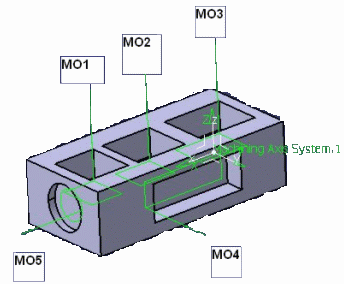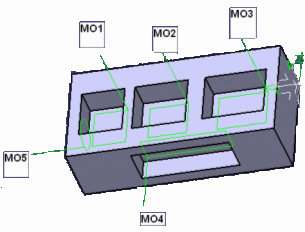Syntax of Generated APT Instructions | |||||||
|
| ||||||
Formats
Blank characters used for presentation comfort on file are not mentioned here.
Example
Example of syntax:
'AUTOPS' 'INDIRV/',F11.5,',',F11.5,',',F11.5' 'TLON,GOFWD/ (CIRCLE/',F13.5,',',F13.5,',',F13.5,',$' F13.5,'),ON,2,INTOF,$' '(LINE/',F13.5,',',F13.5,',',F13.5,',$' F13.5,',',F13.5,',',F13.5,')'
Example of generated APT source:
AUTOPS INDIRV/ 0.00000, -1.00000, 0.00000 TLON,GOFWD/ (CIRCLE/ 0.00000, 0.00000, 0.00000,$ 50.00000),ON,2,INTOF,$ (LINE/ 0.00000, 0.00000, 0.00000,$ 50.00000, 0.00000, 0.00000)
Syntax
| Syntax | Functionality |
|---|---|
'$$',6X,'GENERATED ON ',A28,' AT ',A8 |
|
'PPRINT OPERATION NUMBER: ',I4 '$$ OPERATION NUMBER: ',I4 |
|
A80 |
|
'$$*CATIA0' '$$ ',A70 '$$ ',4(F11.5,2X) '$$ ',4(F11.5,2X) '$$ ',4(F11.5,2X) |
|
'TLAXIS/'F9.6,2(',',F9.6) |
|
'MULTAX/ON' 'MULTAX/OFF' |
|
'GOTO/',F11.5,2(',',F11.5)
'FROM/',F11.5,2(',',F11.5) |
|
'CUTTER/',4(F10.6,','),F10.6,',$' F10.6,',',F10.6 |
|
'INTOL /',F11.5 'OUTTOL/',F11.5 |
|
'FEDRAT/',F10.4 'RAPID' |
|
'GOTO/',F11.5,2(',',F11.5) |
|
'GODLTA/',F11.5,2(',',F11.5) |
|
'AUTOPS' 'INDIRV/',F11.5,',',F11.5,',',F11.5' 'TLON,GOFWD/ (CIRCLE/',F13.5,',',F13.5,',',F13.5,',$' |
|
F13.5,'),ON,(LINE/',F13.5,',',F13.5,',',F13.5,',$' F13.5,',',F13.5,',',F13.5,')' F13.5,'),ON,2,INTOF,$' '(LINE/',F13.5,',',F13.5,',',F13.5,',$' F13.5,',',F13.5,',',F13.5,')' |
|
'PSIS/(PLANE/(POINT/',F11.5,2(',',F11.5),'),PERPTO,$'
'(VECTOR/',2(F9.6,','),F9.6,'))''INDIRV/',F11.5,',',F11.5,',',F11.5 'TLON,GOFWD/(CYLNDR/',2(F11.5,','),F11.5,',$' |
|
3(F11.5,','),F11.5,'),ON,$'
'(PLANE/PERPTO,$'
'(PLANE/(POINT/',F11.5,2(',',F11.5),'),PERPTO,$'
'(VECTOR/',2(F9.6,','),F9.6,')),$' '(POINT/',2(F11.5,','),F11.5,'),$'
'(POINT/',2(F11.5,','),F11.5,'))' |
|
3(F11.5,','),F11.5,'),ON,2,INTOF,$'
'(PLANE/PERPTO,$'
'(PLANE/(POINT/',F11.5,2(',',F11.5),'),PERPTO,$'
'(VECTOR/',2(F9.6,','),F9.6,')),$'
'(POINT/',2(F11.5,','),F11.5,'),$'
'(POINT/',2(F11.5,','),F11.5,'))' |
|
![]()
MULTAX
A MULTAX statement (MULTAX, MULTAX/ON, MULTAX/OFF) can be defined anywhere in the Manufacturing Program (for example, in a PP word statement or a macro path).
MULTAX Influence on APT Output
MULTAX statements found during APT generation can influence
the output format:
- MULTAX statements are searched and identified in any PP
word statement:
- If a MULTAX or MULTAX/ON statement is found, the following linear motions can be written with the format: GOTO/ X, Y, Z, I, J, K.
- If a MULTAX/OFF statement is found, the following linear motions can be written GOTO/ X, Y, Z and the tool axis can be considered as locked. The components of the locked tool axis are the components defined on the last 5-axis position preceding the MULTAX/OFF statement. Therefore, no TLAXIS statement is generated after a MULTAX/OFF statement.
- In a sequence of motions following a MULTAX/OFF statement, the tool axis orientation is checked, and as soon as it is not constant, a MULTAX/ON statement can be added, possibly with a warning message in the NC data output log file.
Example of APT source:
... PPRINT OPERATION NAME : Tool Change PPRINT Start generation of : Tool Change MULTAX/ON GOTO / 0.00000, 27.16535, 20.47244, 0.000000, 0.000000, 1.000000 $$ TOOLCHANGEBEGINNING CUTTER/ 1.259843, 0.000000, 0.629921, 0.000000, 0.000000,$ 0.000000, 0.984250 $$ TOOLCHANGEEND PPRINT End of generation of : Tool Change ... MULTAX/OFF ... RAPID GOTO / 7.29167, 15.48687, 16.10080 RAPID GOTO / 7.29167, 15.48687, 15.13780 ... MULTAX/ON ... RAPID GOTO / 2.74137, 14.56693, 16.10080, 0.000000, 0.000000, 1.000000 RAPID GOTO / 2.74137, 14.56693, 15.13780, 0.000000, 0.000000, 1.000000 ...
![]()
Tool Change Operations and TLAXIS/ Statements in APT Output
The tool change point is specified on the Part Operation and the tool axis at this point is determined by the spindle orientation (I, J, K) on the machine.
Tool Change Position Defined on the Setup
In the particular case where no machine is defined on the Part Operation, this tool axis is determined by the z-axis of the Part Operation machining axis system.
TLAXIS Output
The following applies:
- A tool axis statement (TLAXIS) is always output for the first tool change.
- For the following tool changes, the tool axis of the previous Machining Operation is taken into account.
- If it is different from the Tool Change Point position defined in the setup, a TLAXIS statement is output for that Tool Change.
Example 1

If the tool axis at the Tool Change Point position is (0,0,1), a TLAXIS/ 0.000000, 0.000000, 1.000000 statement is output for the first and fifth tool changes.
$$ OPERATION NAME : Tool Change.1 TLAXIS/ 0.000000, 0.000000, 1.000000 etc $$ Start generation of : Profile Contouring.1 etc $$ Start generation of : Tool Change.2 etc $$ Start generation of : Profile Contouring.2 etc $$ OPERATION NAME : Tool Change.3 etc $$ Start generation of : Tool Change.3 etc $$ Start generation of : Profile Contouring.3 etc $$ Start generation of : Tool Change.4 etc $$ Start generation of : Profile Contouring.4 TLAXIS/ 0.000000, 1.000000, 0.000000 etc $$ Start generation of : Tool Change.5 TLAXIS/ 0.000000, 0.000000, 1.000000 etc $$ Start generation of : Profile Contouring.5 TLAXIS/ 1.000000, 0.000000, 0.000000
Example 2

If the tool axis at the Tool Change Point position is (0,0,1) and the tool axes of all the Machining Operations are different from the Tool Change Point position axis, a TLAXIS/ 0.000000, 0.000000, 1.000000 statement is output for all the tool changes.
$$ Start generation of : Tool Change.1 TLAXIS/ 0.000000, 0.000000, 1.000000 etc $$ Start generation of : Profile Contouring.1 TLAXIS/ 0.000000, 1.000000, 0.000000 etc $$ Start generation of : Tool Change.2 TLAXIS/ 0.000000, 0.000000, 1.000000 etc $$ Start generation of : Profile Contouring.2 TLAXIS/ 0.000000, 1.000000, 0.000000 etc $$ Start generation of : Tool Change.3 TLAXIS/ 0.000000, 0.000000, 1.000000 etc $$ Start generation of : Profile Contouring.3 TLAXIS/ 0.000000, 1.000000, 0.000000 etc $$ Start generation of : Tool Change.4 TLAXIS/ 0.000000, 0.000000, 1.000000 etc $$ Start generation of : Profile Contouring.4 TLAXIS/ 0.000000, 0.000000,-1.000000 etc $$ Start generation of : Tool Change.5 TLAXIS/ 0.000000, 0.000000, 1.000000 etc $$ Start generation of : Profile Contouring.5 TLAXIS/ 1.000000, 0.000000, 0.000000
![]()
Non-Modal Behavior of RAPID Statements
According to APT standard formats, all feedrate statements (except RAPID) are modal. This means that they are applied to all the following points until the next the feedrate statement.
However:
- the RAPID instruction is not modal: the RAPID statement is applied
only to the next GOTO motion.
For example, in a linking macro with rapid feedrate, a RAPID instruction is written before each of the three GOTO points of the macro.
- Another APT standard format rule that is specific to the RAPID word is to not repeat the current machining feedrate after the last point in RAPID. The machining feedrate can be applied.
In the example below:
- the rapid feedrate only applies to the first GOTO point.
- The machining feedrate that was current before the RAPID statement applies to the second GOTO point.
FEDRAT/ 300.0000,MMPM GOTO / -69.00000, 40.00000, 46.00000 GOTO / -69.00000, 50.00000, 0.00000 RAPID GOTO / -80.0000, -23.0000, 16.0000 GOTO / -90.0000, -21.0000, 16.0000
![]()
Helical Interpolation
A helical interpolation instruction can be generated in the output file (APT source or CLFile) for Machining Operations that support helical tool motions.
These Machining Operations include Thread Milling, Circular Milling in Helical mode, Sequential Groove with Helical motions, and Profile Contouring defined with a Helix tool path style.
It requires that:
- The machine specified in the Part Operation supports helical interpolation.
- The Helical interpolation check box is selected in the Numerical Control tab of the machine. See Working with Generic Machine Editor. Otherwise, GOTO instructions are generated for the helical motion.
Note:
![]() By default,
the Generate NC Output Interactively dialog box inherits the machine parameters, so the Helical interpolation check box is
also selected in that dialog box. Do not switch the Helical interpolation check box to local modifications mode. See
Generating NC Code and Working with Generic Machine Editor.
By default,
the Generate NC Output Interactively dialog box inherits the machine parameters, so the Helical interpolation check box is
also selected in that dialog box. Do not switch the Helical interpolation check box to local modifications mode. See
Generating NC Code and Working with Generic Machine Editor.
![]()
Automatic Generation of ROTABL and TLAXIS for Mill-Lathe Changeover
Mill-Turn integration enables automatic generation of:
- a ROTABL statement in output every time there is a change-over from a Turning operation to a Milling operation
- a TLAXIS statement in output every time there is a change-over from a Milling operation to a Turning operation.
Example of Insertion of ROTABL/ Statement:
ROTABL/ 0.000000,CLW $$*CATIA0 $$ UNKNOWN $$ 0.00000 1.00000 0.00000 0.00000 $$ 0.00000 0.00000 1.00000 0.00000 $$ 1.00000 0.00000 0.00000 0.00000
Example of Insertion of TLAXIS Statement:
FEDRAT/ 0.2500,IPR GOTO / 1.62000, 0.00000, 0.00000 $$ End of generation of : Drilling .875 Dia. $$ OPERATION NAME : ROUGH FACE GROOVE * $$ Start generation of : ROUGH FACE GROOVE * $$ TOOLCHANGEBEGINNING RAPID GOTO / 20.00000, 8.00000, 0.00000 CUTTER/ 0.120000 COUPLE/40,REAR CALL/TCHG,ST=05,CSS=180,RGE=1,DIR=CLW $$ TOOLCHANGEEND $$ End of generation of : ROUGH FACE GROOVE * $$ OPERATION NAME : Turning Axis $$ Start generation of : Turning Axis TLAXIS/ 0.000000, 0.000000, 1.000000 $$*CATIA0 $$ Turning Axis $$ -1.00000 0.00000 0.00000 1.63500 $$ 0.00000 0.00000 1.00000 0.00000 $$ 0.00000 1.00000 0.00000 0.00000 $$ End of generation of : Turning Axis $$ OPERATION NAME : Rough Groove Front 1 $$ Start generation of : Rough Groove Front 1 FEDRAT/ 100.0000,IPM GOTO / 3.63500, 3.00000, 0.00000 GOTO / 3.63500, 1.56762, 0.00000
Note:
- There is no activity created for the ROTABL statement. You cannot see an activity corresponding to this ROTABL statement. The tool path replay does not show this rotation. It can only be seen in the APT output.
- After the APT Import, an activityis created for this ROTABL or TLAXIS statement.
- If a Machine Rotation activity is already in place between a Turning and a Milling operation, no additional ROTABL/ is generated in the APT output.